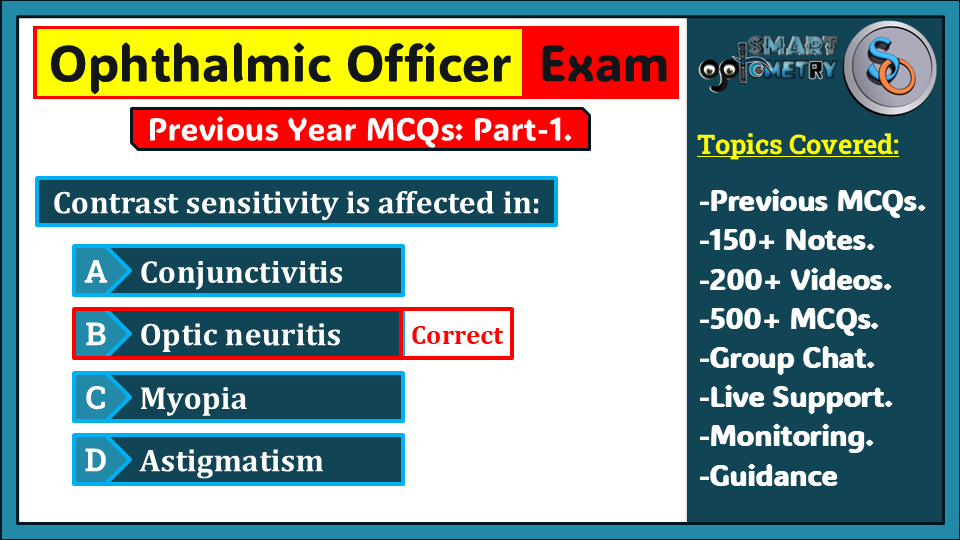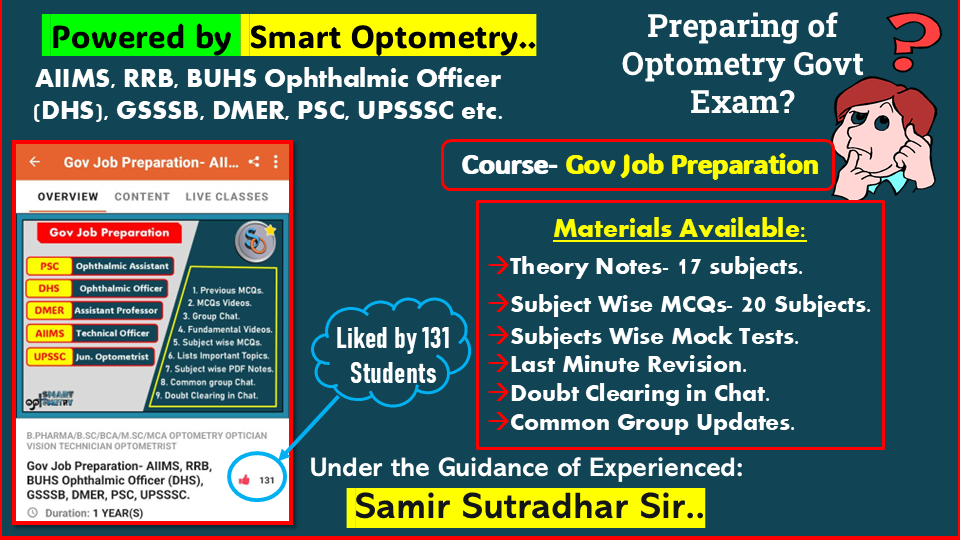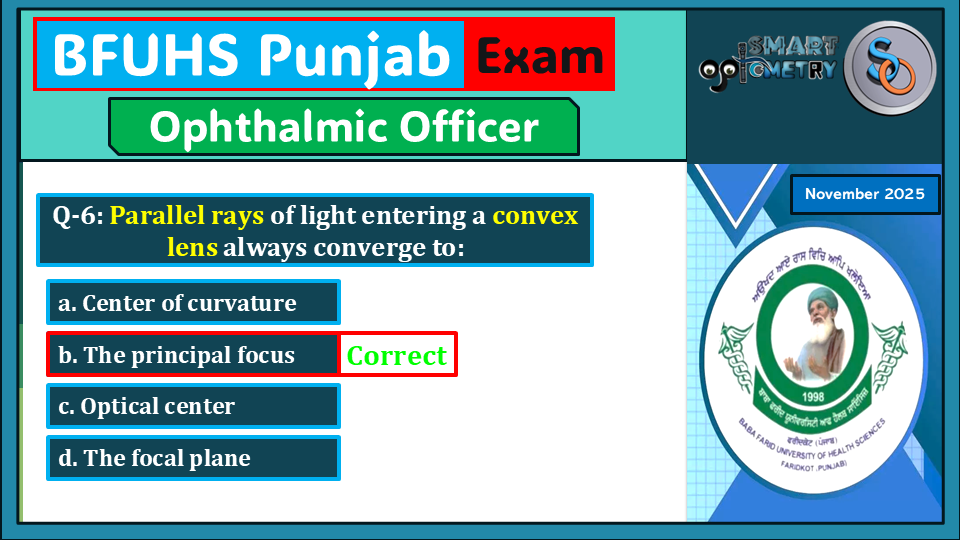1. Which is not a viscoelastic?
- A) 1% sodium hyaluronate
- B) 3% methylcellulose
- C) 5% acetyl cysteine
- D) 2% hypermellose
Click “Show more” to see the answer and explanation.
Answer: C) 5% acetyl cysteine
Explanation:
Acetyl cysteine is a mucolytic agent, not a viscoelastic. Viscoelastic substances are used in ophthalmic surgeries to maintain the anterior chamber, whereas acetyl cysteine is used to treat mucus-related eye conditions.
.
.
2. Contrast sensitivity is affected in:
- A) Conjunctivitis
- B) Optic neuritis
- C) Myopia
- D) Astigmatism
Click “Show more” to see the answer and explanation.
Answer: B) Optic neuritis
Explanation:
Optic neuritis, an inflammation of the optic nerve, affects visual functions, including contrast sensitivity, color vision, and visual acuity.
Note: Prepare for Ophthalmic Officer Exam by DHS with our course “MCQs in Optometry”. This course provides: Basic Notes, Fundamental Videos, Subjectwise MCQs, PDF MCQs, Previous Years MCQs, RAPID Access Guide for Optometrists PDF Book, Group Chat, Live Support.
.
.
3. The average corneal endothelial cell count is:
- A) 2500/sq mm
- B) 1000/sq mm
- C) 3900/sq mm
- D) 4800/sq mm
.
.
4. Which of these help in visualization of corneal cells?
- A) Confocal microscope
- B) Optical coherence tomography
- C) Pachymeter
- D) Slit lamp biomicroscope
.
.
5. Which of these helps in in-vivo visualization of retinal layers?
- A) Confocal microscope
- B) Optical coherence tomography
- C) Pachymeter
- D) Slit lamp biomicroscope
.
.
6. Conjunctival mucus is deficient in all these conditions except:
- A) Old trachoma
- B) Steven Johnson syndrome
- C) Ocular pemphigoid
- D) Sjogren’s syndrome
Click “Show more” to see the answer and explanation.
Answer: A) Old trachoma
Explanation:
Conjunctival scarring in trachoma does not necessarily cause mucus deficiency, unlike other conditions where goblet cells are directly affected.
Note: Prepare for your Ophthalmic Officer Exam by DHS under experience Samir Sutradhar sir. Enroll in our Course “MCQs in Optometry” that will give you: Basic Notes, Fundamental Videos, Subjectwise MCQs, PDF MCQs, Previous Years MCQs, RAPID Access Guide for Optometrists PDF Book, Group Chat, Live Support.
.
.
7. Which does not hold true for central serous choroidopathy?
- A) Smoke stack appearance of FFA
- B) Ink blot appearance on FFA
- C) Seen more in anxious males
- D) Vision correctable by concave lenses
.
.
8. All statements hold true for retinal tamponade using silicon oil except:
- A) Produces secondary glaucoma
- B) Expands during air travel
- C) Should be removed after 8-12 weeks
- D) Can lead to inverse hypopyon if emulsified
.
.
9. Which of these anti-glaucoma drugs are contraindicated in patients with sulpha allergy?
- A) Bimatoprost
- B) Brinzolamide
- C) Timolol maleate
- D) Travoprost
.
.
10. In contact lens users, the most common cause of infection is:
- A) Pneumococcus
- B) Streptococcus
- C) Pseudomonas
- D) Staphylococcus
Click “Show more” to see the answer and explanation.
Answer: C) Pseudomonas
Explanation:
Pseudomonas aeruginosa is the most common pathogen causing keratitis in contact lens users.
Note: Our Course “MCQs in Optometry” with 95% success rate will help to prepare for Ophthalmic Officer Exam by DHS. Prepare under experienced Samir Sutradhar sir.
.
.
11. Following are the risk factors for contact lens-related microbial keratitis except:
- A) Female sex
- B) Excessive crying
- C) Overnight wear
- D) Daily disposable contact lenses
Click “Show more” to see the answer and explanation.
Answer: C) Overnight wear
Explanation:
Microbial keratitis is an infection of the cornea and is a serious complication of contact lens wear. Risk factors include:
Overnight wear: Wearing contact lenses overnight reduces oxygen supply to the cornea, promoting bacterial growth.
Female sex: Research shows women are more likely to develop microbial keratitis due to improper lens hygiene or extended use.
Daily disposable contact lenses: While less risky compared to reusable lenses, improper handling or contamination can still lead to microbial keratitis.
Excessive crying is not a documented risk factor as it does not directly impact the cornea’s exposure to pathogens from contact lenses.
.
.
12. While doing retinoscopy, red reflex moves in the opposite direction to the retinoscope. This indicates:
- A) Hypermetropia
- B) Myopia greater than 1D
- C) Myopia of 1D
- D) Myopia lesser than 1D
Click “Show more” to see the answer and explanation.
Answer: B) Myopia greater than 1D
Explanation:
Here, without placing working distance power the reflex is opposite or against. When reflex is against movement without working distance power then its myopia of more than working distance power. Normal working distance is 1D to 1.5D. So only possible answer is b. “myopia greater than 1D”.
.
.
13. Steroid drop with the greatest anti-inflammatory action is:
- A) Loteprednol
- B) Fluorometholone
- C) Ketorolac
- D) Prednisolone acetate
.
.
14. Image formed by a prism is:
- A) Virtual, erect, displaced towards its apex
- B) Inverted, real, displaced towards apex
- C) Virtual, inverted, displaced towards apex
- D) Real, erect, displaced towards apex
Click “Show more” to see the answer and explanation.
Answer: A) Virtual, erect, displaced towards its apex
Explanation:
A prism displaces light rays towards its base, but the image formed is virtual and appears to be shifted towards the apex.
Note: Enroll in our Course “MCQs in Optometry” to prepare for Ophthalmic Officer Exam by DHS under Experienced Samir Sutradhar sir. This course will give you: Basic Notes, Fundamental Videos, Subjectwise MCQs, PDF MCQs, Previous Years MCQs, RAPID Access Guide for Optometrists PDF Book, Group Chat, Live Support.
.
.
15. Which of these statements is false regarding retinoblastoma?
- A) It is an inheritable tumor
- B) It can be treated by cataract surgery
- C) It occurs in children 1 to 4 years of age
- D) Presents as white pupillary reflex
.
.
16. Postoperative medications not given after cataract surgery is:
- A) Moxifloxacin eye drops
- B) Travoprost eye drops
- C) Dexamethasone eye drops
- D) Bromfenac eye drops
.
.
17. Which are not the uses of single or double frequency Nd:YAG laser?
- A) Spectacle removal
- B) Laser iridotomy
- C) Pan retinal photocoagulation in diabetic retinopathy
- D) Ablation of posterior capsular opacification
Click “Show more” to see the answer and explanation.
Answer: A) Spectacle removal
Explanation:
Nd:YAG lasers are used for iridotomy, posterior capsular opacification ablation, and sometimes diabetic retinopathy treatment, but not for removing spectacles.
Note: Prepare for Ophthalmic Officer Exam by DHS with our course “MCQs in Optometry”. This course provides: Basic Notes, Fundamental Videos, Subjectwise MCQs, PDF MCQs, Previous Years MCQs, RAPID Access Guide for Optometrists PDF Book, Group Chat, Live Support.
.
.
18. A ray of light passing through the principal focus of a convex lens, after refraction, will pass:
- A) Through the principal focus
- B) Parallel to the principal axis
- C) Without any deviation
- D) Will undergo total internal reflection
.
.
19. A bifocal lens is used as a remedy for which of the following diseases of the eye?
- A) Myopia
- B) Presbyopia
- C) Hypermetropia
- D) Astigmatism
.
.
20. The image formed by a concave mirror is real, inverted, and of the same size as that of the object. The position of the object should be:
- A) At the focus
- B) At the center of curvature
- C) Between the focus and center of curvature
- D) Between the focus and the lens
Click “Show more” to see the answer and explanation.
Answer: B) At the center of curvature
Explanation:
When an object is placed at the center of curvature of a concave mirror, the image is real, inverted, and of the same size as the object.
Note: Prepare for your Ophthalmic Officer Exam by DHS under experience Samir Sutradhar sir. Enroll in our Course “MCQs in Optometry” that will give you: Basic Notes, Fundamental Videos, Subjectwise MCQs, PDF MCQs, Previous Years MCQs, RAPID Access Guide for Optometrists PDF Book, Group Chat, Live Support.
.
.
Are you preparing for the Ophthalmic Officer Exam and looking for comprehensive guidance to ace it? In this blog, we present 20 previous year MCQs carefully selected from the Ophthalmic Officer Exam Previous Year Question Papers, designed to help you understand the Ophthalmic Officer Exam Pattern and boost your preparation. Whether you’re exploring the Ophthalmic Officer Exam Syllabus or searching for the best Ophthalmic Officer Exam Study Material, this blog has got you covered.
We also provide insights into the Ophthalmic Officer Exam Eligibility Criteria, guiding you on how to apply through the Ophthalmic Officer Exam Application Form and stay updated on the Ophthalmic Officer Exam Recruitment Notification. Don’t miss important updates like the release of the Ophthalmic Officer Exam Admit Card, Ophthalmic Officer Exam Dates, and Ophthalmic Officer Exam Result to ensure you’re always one step ahead.
This blog is a must-read for aspirants aiming to succeed in the Ophthalmic Officer Exam with ease. Dive in to test your knowledge and enhance your preparation today!
- Check Our Courses: Ophthalmic Instrumentation, Clinical Refraction, Contact Lens, Binocular Vision, Dispensing Optics, MCQs in Optometry
- Download our App “Optometry Notes & MCQs” from Google Play Store.




